#arenenberg
Photo

Bild des Tages: Schnee auf dem Arenenberg
2 notes
·
View notes
Text
Greetings from the Napoleon Museum Arenenberg










0 notes
Text

Hortense de Beauharnais in 1832, during her exile in Arenenberg.
26 notes
·
View notes
Note
Hello!
I've also read from you about Hortense writing about her rivalry with Caroline in her memoirs, all the while keeping a friendly correspondence with her. Why would Hortense do this, in your opinion? Were she secretely holding a grudge or something?
Thank you for the question. As to the answer... Well, your guess is as good as mine. 😀
It never hurts to remember that Hortense's memoirs are not a spontaneous outpouring of the heart, but a much-revised document, started only after the fall of the empire, when Hortense was exiled from France, and only finished in 1832. It was very much not intended for publication, but for that small circle of friends and admirers she assembled around her at Arenenberg to whom she read from them. She surely never would have let Caroline see it.
Memoirs are always a problematic source, these, in my opinion, especially so. I tend to think that Hortense had lots of personal issues (like all three Beauharnais, like possibly everybody of us) that gradually worsened in her marriage to a husband she did not love. She craved (CRAVED!) admiration, recognition and attention, the moment she didn't get it, she got sick. (Btw, I believe that is the real reason why she used every trick in the book in order to leave Holland and to stay at Napoleon's court. Not because she was in love with her stepfather, but because at court she had every opportunity to show off.) She was both courageous and strong-willed (quite unlike the fragile and timid woman she described in her memoirs) and had a real taste for adventures. But those character traits were undesirable in a woman, according to the moral concepts of her time. So in her memoirs Hortense always needs to show herself in a desperate situation, driven to what she did by circumstances.
The memoirs are - again, in my opinion - to be taken with a huge grain of salt. I'm very much down with Eugène's Auguste on this one!
As to her relationship with Caroline, Hortense still still was in correspondence with her in the 1830s. When Madame Mère in Rome broke her leg, it was Hortense who wrote to Caroline about it (Caroline being exiled to Trieste). How she could keep this up while turning Caroline into her personal antagonist in her memoirs is beyond me. I would have been ashamed of myself. But then again, maybe she really did not think too much about it. She was, imo, a rather superficial person, much like her mother and even her brother. Maybe a psychological reaction to the fears and insecurities of her childhood: better not give too much importance to anything, who knows how long you'll have it.
As for her holding grudges ... yes, possibly, though this is now really pure speculation on my part. If she did hold a grudge, then surely not for anything that Caroline did to her, but because Hortense at heart was jealous of Caroline. Caroline had been allowed to marry for love, while Hortense had been "sold off", so to speak, into a political marriage. For this, Hortense at least should have become first lady of the court and mother to Napoleon's successor - but even that she did not receive, once Napoleon decided to remarry. So, Caroline always got the good stuff: Handsome Murat, when Hortense had to deal with sicklish, crippled Louis. Even Murat's aides were much better looking than Louis'! Murat could dance and he was outgoing and friendly, while Louis suffered from his diseases and turned morose. Finally, Caroline got beautiful Naples, when Hortense gut ugly (almost fatal) Holland (she pretty much decided she would hate the country as soon as she crossed the border).
Again, all that is speculation. Fact is, I have not yet found any clear sign of animosity by Caroline to Hortense. But plenty the other way around. So, as far as dishonesty in this friendship between two women is concerned, Hortense seems to beat Caroline by a mile.
Sorry if I do not have a better answer to offer. But I'm not a historian, and this opinion of mine is already so far opposed to what most historians think of Hortense that I feel quite pretentious writing it down.
27 notes
·
View notes
Text
Princess Imperial 1.09

Evie gasped when she first saw the chateau. They’d been driving through the snow-covered Swiss countryside for nearly an hour. The closer they got to Arenenberg, the thicker the fog surrounding their car became. She had no idea where they were until they passed through a set of enormous iron gates. All at once, the fog thinned, revealing a stately pale yellow manor house. It was three stories tall. The windows were trimmed with kicky turquoise paint.
The car lurched to a stop. Evie clambered out. The air was chilly. She’d been too warm, in the car, wearing a cashmere sweater and a coat, but her outfit was perfect now.
Julien stopped beside her. He gestured in the direction of the fog. “That’s Lake Constance. Bodensee, if you speak German.”
“Which I don’t,” Evie said flatly.
Read the rest at princessimperial.com

1 note
·
View note
Photo



Fachstellenhaus / Staufer & Hasler Architekten
Photos © Roland Bernath
85 notes
·
View notes
Photo
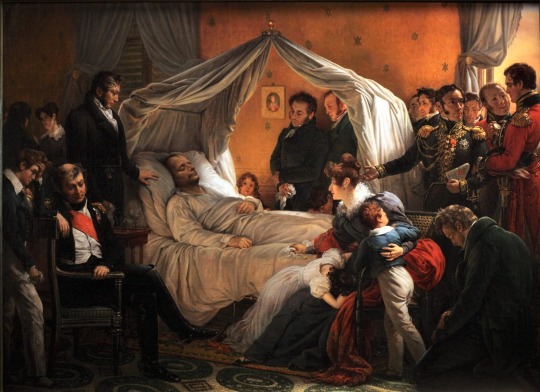
Vivant, il a manqué le monde ; mort, il le possède.
- François René de Chateaubriand (1768-1848), Vie de Napoléon, livres XIX à XXIV des Mémoires d’outre-tombe (posthume)
Of course we don’t have any photograph or film of Napoleon’s death on 5 May 1821 on Saint Hélène. But we do have the next best thing: a painting. Charles de Steuben depiction of Napoleon's deathbed and his faithful entourage that served as witnesses to his dying moments became the one of the most important paintings of the post-Napoleonic era but then faded from modern memory.
I first came across it by accident when I was in my teens at my Swiss boarding school. There were times I found myself with school friends going away on hiking trips around the high Alpine chain of the Allgäu Alps and we would drive through Lake Constance to get there, or we would hike around the Lake itself through the Bodensee-Rundwanderweg.
Perched high above Lake Constance and nestled in large parklands, stood Schloss Arenenberg which overlooks the lower part of Lake Constance. At first, it appears a relatively modest country house. But this was no usual pretty looking house. Arenenberg was owned by well-heeled families before it was sold to Hortense de Beauharnais, the adopted daughter and sister-in-law of the French Emperor himself, Napoleon Bonaparte. She had it rebuilt in the French Empire style and lived there from 1817 with her son Louis Napoleon, later Emperor Napoleon III, who is said to have spoken the Thurgau dialect in addition to French. This elegantly furnished castle then was once the residence of the last emperor of France.
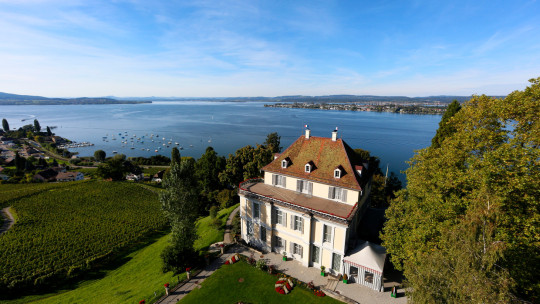
The alterations made first by Queen Hortense and later by Empress Eugénie have been carefully preserved and the house still bears the marks of both women. Queen Hortense's drawing room is perfectly preserved and visitors can still admire her magnificent library (all marked with the Empress' cipher) containing over one thousand books. Likewise, in the room where the queen died, every object has been maintained in its original condition: pieces of furniture and personal belongings are gathered here to evoke her memory in a very touching manner. As for Empress Eugénie's rooms, they too have been very carefully preserved. Her private drawing room is a perfect illustration of the Second Empire style with sculptures by Carpeaux and portraits of the imperial family by Winterhalter.
After 1873, the Empress and the Imperial Prince brought the palace back to life by making regular summer visits, which they continued until 1878. However, on the tragic death of her son in 1879, Eugénie found it difficult to return to a place so full of painful memories. And so in 1906 she donated the estate to the canton of Thurgovie as a testimony of her gratitude for the region's faithful hospitality towards the Napoleon family. And in accordance with the Empress' wishes, the residence was turned into a museum devoted to Napoleon.
In what is now the Napoleonic Museum, the original furnishings have been preserved, and the palace gardens had been fully restored. This in itself might be worth a visit for the view over Lake Constance which is stunning. For Napoleonic era buffs though its the incredible art collection which is its real treasure. It houses an important art collection including works by the First-Empire artists Chinard Canova, Gros, Robert Lefèvre, Gérard, Isabey and Girodet-Trioson, and by the Second-Empire painters and sculptors Alfred de Dreux, Winterhalter, Carpeaux, Meissonier, Hébert, Flandrin, Detaille, Nieuwerkerke and Giraud.
But what caught my eye was this painting, ‘La Mort de Napoléon’ by Charles de Steuben. I didn’t know anything about it or the artist for that matter, but one of my more erudite school friends who, being French, was into Napoleonic stuff in a huge way, and she explained it all to me. Of course I knew a fair bit about Napoleon growing up because my grandfather and father, being military men themselves, were Napoleonic warfare buffs and it rubbed off onto me. I just knew about Napoleon the military genius. I never thought about him once he was beaten at Waterloo in 1815. So I never really engaged with Napoleon the man. And yet here I was staring at his last breath of mortality caught forever in time through art. Not for the first time I had mixed feelings about Napoleon Bonaparte, both the man and the myth (built up around him since his death).
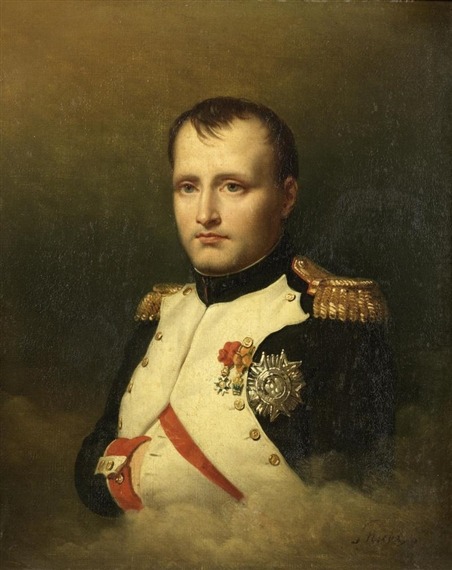
On 5 May, 1821, at 5.49pm in Longwood House on the remote island of St Helena, in the words of the famed French man of letters, François-René de Chateaubriand, ‘the mightiest breath of life which ever animated human clay’ came no more. To the British, Dutch, and Prussian coalition who had exiled Naopleon Bonaparte there in 1815, he was a despot, but to France, he was seen as a devotee of the Enlightenment.
In the decade following his demise, Napoleon’s image underwent a transformation in France. The monarchy had been restored, but by the late 1820s, it was growing unpopular. King Charles X was seen as a threat to the civil liberties established during the Napoleonic era. This mistrust revived Napoleon’s reputation and put him in a more heroic light.
Fascination with the French leader’s death led Charles de Steuben, a German-born Romantic painter living in Paris, to immortalise the momentous event. Steuben’s painting depicts the moment of Napoleon’s death and seeks to capture the sense of awe in the room at the death of a man whose legendary career had begun in the French Revolution. It was this, ultimate moment that Steuben wished to immortalise in a painting which has since become what could almost be described as the official version of the scene.

There is no question that Steuben’s painting became the most famous and most iconic depiction of Napoleon’s death in art history. In another painting, executed during the years 1825-1830, Steuben was to give a realistic view of the emperor dictating his memoirs to general Gourgaud. This same realism also pervades his version of Napoleon’s death, and it is totally unlike Horace Vernet’s, Le songe de Bertrand ou L’Apothéose de Napoléon (Bertrand’s Dream or the apotheosis of Napoleon) which, although painted in the same year, is an allegorical celebration of the emperor’s martyrdom and as such the first stone in the edifice of the Napoleonic legend.
And what a legend Napoleon’s life was turned into for time immemorial. Napoleon declared himself France’s First Consul in 1799 and then emperor in 1804. For the next decade, he led France against a series of European coalitions during the Napoleonic Wars and expanded his empire throughout much of continental Europe before his defeat in 1814. He was exiled to the Mediterranean island of Elba, but he escaped and briefly reasserted control over France before a crushing final defeat at the Battle of Waterloo in 1815.
Napoleon’s military prowess earned him the fear of his enemies, but his civil reforms in France brought him the respect of his people. The Napoleonic Code, introduced in 1804, replaced the existing patchwork of French laws with a unified national system built on the principles of the Enlightenment: universal male suffrage, property rights, equality (for men), and religious freedom. Even in his final exile on St. Helena, Napoleon proved a magnetic presence. Passengers of ships docked to resupply would hurry to meet the great general. He developed strong personal bonds with the coterie who had accompanied him into exile. Although some speculate that he was murdered, most agree that Napoleon’s death in 1821, at the age of 51, was the result of stomach cancer.
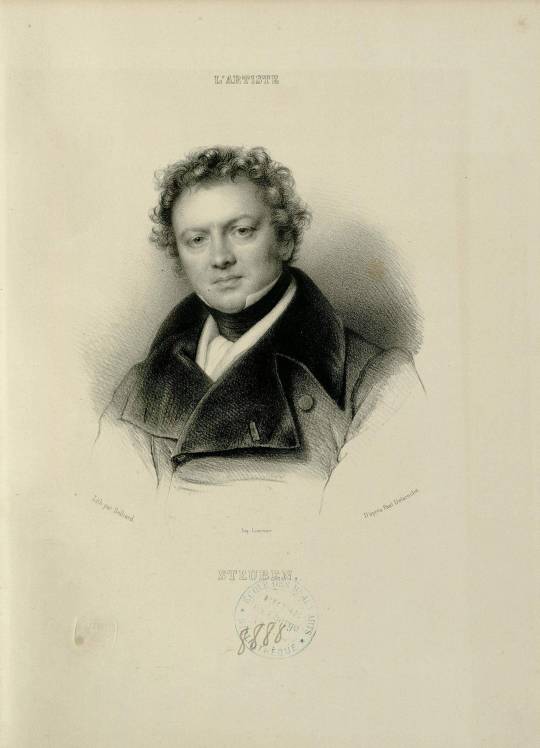
By contrast, Charles de Steuben was born in 1788, his youth and artistic training coinciding with Napoleon’s rise to power. He was the son of the Duke of Württemberg officer Carl Hans Ernst von Steuben. At the age of twelve he moved with his father, who entered Russian service as a captain, to Saint Petersburg, where he studied drawing at the Art Academy classes as a guest student. Thanks his father's social contacts in the court of the Tsar, in the summer of 1802 he accompanied the young Grand Duchess Maria Pavlovna of Russia (1786–1859) and granddaughter of Frederick II Eugene, Duke of Württemberg, to the Thuringian cultural city of Weimar, where the Tsar's daughter two years later married Charles Frederick, Grand Duke of Saxe-Weimar-Eisenach (1783–1853). Steuben, then fourteen years old, was a Page at the ducal court, a position for which the career prospects would be in the military or administration. The poet Friedrich Schiller was a family friend who at once recognised De Steuben's artistic talent and instilled in him his political ideal of free self-determination regardless of courtly constraints.
At the behest of Pierre Fontaine in 1828 de Steuben painted La Clémence de Henri IV après la Bataille d'Ivry, depicting a victorious Henry IV of France at the Battle of Ivry. De Steuben's Bataille de Poitiers, en octobre 732, painted between 1834 and 1837, shows the triumphant Charles Martel at the Battle of Tours, also known as the Battle of Poitiers. He painted Jeanne la folle around the same time and he was commissioned by Louis Philippe to paint a series of portraits of past Kings of France.
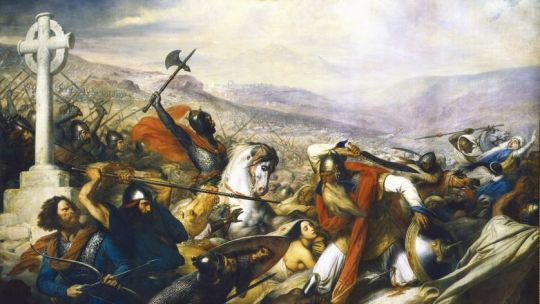
Life in the French capital was a repeated source of internal conflict for Steuben. The allure of bohemian Paris and his military-dominated upbringing made him a wanderer between worlds. As an official commitment to his adopted country he became a French citizen in 1823. However, the irregularity of his income as a freelance artist was in contrast to his sense of duty and social responsibility. To secure his family financially, he took a job as an art teacher at École Polytechnique, where he briefly trained Gustave Courbet. In 1840 he was awarded a gold medal at the Salon de Paris for his highly acclaimed paintings.
The love of classical painting was a lifelong passion of Steuben. He was a close friend to Eugène Delacroix, the leader of the French Romantic school of painting, whom he portrayed several times. Steuben was also part of this artistic movement, which replaced classicism in French painting. "The painter of the Revolution," as Jacques-Louis David was called by his students, joined art with politics in his works. The subjects of his historical paintings supported historical change. He painted mainly in sharp colour contrasts, heavy solid contours and clear outlines. The severity of this style led many contemporary artists - including Prud'hon - to a romanticised counter movement. They preferred the shadowy softness and gentle colour gradations of Italian Renaissance painters such as Leonardo da Vinci and Antonio da Correggio, whose works they studied intensively. Steuben, who had begun his training with David, felt the school was becoming increasingly rigid and dogmatic. Critics praised his deliberate compositions, excellent brush stroke and impressive colour effects. But some of his critics felt that his pursuit of dramatic design of rich people also showed, at times, a pronounced tendency toward the histrionic.
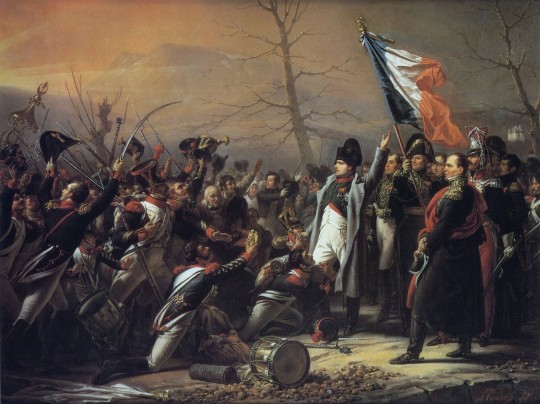
The portrayal of key moments in Napoleon’s dramatic military career would feature among some of Steuben’s best known works. But it is this death scene that Steuben is most remembered for.
Using his high-level contacts among figures in Napoleon’s circle, Steuben interviewed and sketched many of the people who had been present when Napoleon died at Longwood House on St. Helena. He wanted to attempt o give the most accurate representation of the scene possible. Indeed, the painter interviewed the companions of Napoleon’s captivity on their return to France and had them pose for their portraits. Only the Abbé Vignali, captain Crokat and the doctor Arnott were painted from memory. The Grand maréchal Bertrand made sketches of the plan of the room, noting the positions of the different pieces of furniture and people in the room. All the protagonists within the painting brought together some of their souvenirs and in posing for the painter, each person can be seen contributing to a work of collective memory, very much with posterity in mind.
Painstakingly researched, Steuben painted a carefully composed scene of hushed grief. Notable among the figures are Gen. Henri Bertrand, who loyally followed Napoleon into exile; Bertrand’s wife, Fanny; and their children, of whom Napoleon had become very fond.
The best known version of “La Mort de Napoléon” was completed in 1828. French writer Stendhal considered it “a masterpiece of expression.” In 1830 the installation of a more liberal monarchy in France further boosted admiration of Napoleon, who suddenly became a wildly popular figure in theatre, art, and music. This fervour led to the diffusion of Steuben’s deathbed scene in the form of engravings throughout Europe in the 1830s. As Napoleon’s stock arose within French culture and arts, so did Steuben’s depiction of Napoleon’s death. It became a grandeur of vision that permeated Steuben’s masterpiece of historical reconstruction.
Initially forming part of the collection of the Colonel de Chambrure, the painting was put up for auction in Paris, on 9 March 1830, with other Napoleonic works, notably Horace Vernet’s Les Adieux de Fontainebleau (The Fontainebleau adieux) and Steuben’s Retour de l’île d’Elbe (The return from the island of Elba). The catalogue noted that the painting had already been viewed in the colonel’s collection by “three thousand connoisseurs” – which alone would have made it a success -, but its renown was to be further amplified by the production of the famous engraving. The diffusion of this engraving by Jean-Pierre-Marie Jazet (1830-1831, held at the Musée de Malmaison), reprinted and copied countless times throughout the 19th century, made the scene a classic in popular imagery, on a level of popularity with paintings such as Millet’s Angelus.
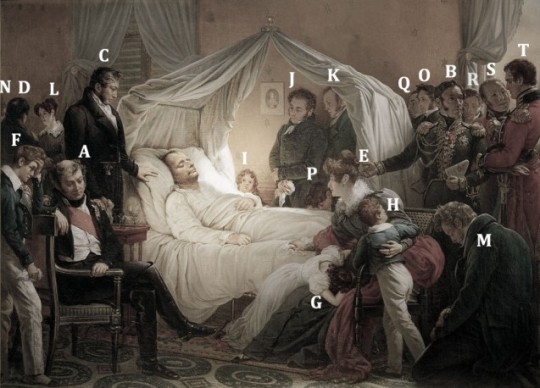
A / Grand Marshal Henri-Gatien Bertrand. Utterly loyal servant of Napoleon’s to the last. His memoirs of the exile on St Helena were not published until 1849. Only the year 1821 has ever been translated into English.
B / General Charles Tristan de Montholon. Courtier and companion of Napoleon’s exile. Montholon managed to ease Bertrand out and become Napoleon’s closest companion at the end, highly rewarded in Napoleon’s will, which Montholon helped write. Montholon’s untrustworthy memoirs were published in 1846/47.
C / Doctor Francesco Antommarchi. Corsican anatomy specialist. Sent by Napoleon’s mother from Rome to St Helena to be Napoleon’s personal physician on the expulsion of Barry O’Meara. Napoleon disliked and distrusted Antommarchi. Antommarchi’s untrustworthy memoirs were very influential and published in 1825.
D / Angelo Paolo Vignali, Abbé. Corsican assistant-chaplain, sent by Madame Mère from Rome to St Helena in 1819.
E / Countess Françoise Elisabeth “Fanny” Bertrand and her children: Napoléon (F), who carried the censer at Napoleon’s funeral; Hortense (G); Henry (H); and Arthur (I), youngest by six years of all the Bertrand children and born on the island. She was wife of the Grand Marshal, very unwilling participant in the exile on St Helena. Her relations with Napoleon were difficult since she refused to live at Longwood. She spoke fluent English. Was however very loyal to Napoleon.
J / Louis Marchand. Napoleon’s valet from 1814 on and one of his closest servants. As Napoleon noted in his will, “The service he [Marchand] rendered were those of a friend”.
K / “Ali”, Louis Étienne Saint-Denis. Known as “the Mamluk Ali”, one of Napoleon’s longest-serving and intimate servants; He became Librarian at Longwood and was an indefatigable copyist of imperial manuscripts.
L / Ali’s English (Catholic) wife, Mary ‘Betsy’ Hall. She was sent out from England by UK relatives of the Countess Bertrand to be governess/nursemaid to the Bertrand children. Married Ali aged 23 in October 1819.
M / Jean Abra(ha)m Noverraz. From the Vaud region in Switzerland. Very tall and imposing figure that Napoleon called his “Helvetic bear”. He was himself ill during Napoleon’s illness.
N / Noverraz’s wife, Joséphine née Brulé. They married in married in July 1819, and she was the Countess Montholon’s lady’s maid. Noverraz and Saint-Denis had a fist fight for the hand of Joséphine.
O / Jean Baptiste Alexandre Pierron. The cook, dessert specialist, long in Napoleon’s service and who had accompanied Napoleon to Elba.
P /Jacques Chandelier. Iincorrectly identified on the picture as Santini who had left the island in 1817. A cook, from the service of Pauline Bonaparte, Napoleon’s sister, who arrived on St Helena with the group from Rome in 1819.
Q /Jacques Coursot. Butler, from the service of Madame Mère, Napoleon’s mother, he arrived on St Helena with the group from Rome in 1819.
R / Doctor Francis Burton. Irish surgeon in the 66th regiment who had arrived on St Helena only on 31st March 1821. He is renowned for having made Napoleon’s death mask (with ensign John Ward and Antommarchi).
S/ Doctor Archibald Arnott. Surgeon in the 20th regiment. Brought in to tend to Napoleon in extremis on 1 April 1821.
T/ Captain William Crokat. A Scot, orderly officer at Longwood for less than a month, having replaced Engelbert Lutyens on 15 April. He received the honour of carrying the news of Napoleon’s death back to London and also the reward, namely, a promotion and £500, privileges of which Lutyens was deliberately deprived by the governor.
#charles de steuben#art#painting#napoleon#bonaparte#st helena#life#death#chateaubriand#french#france#emperor#artist#aesthetics#war#politics#society#culture#arts#personal
38 notes
·
View notes
Text
30.6.2021 | Arenenberg | 11.30h
Zwar umfasse der Landschaftspark nur 13 Hektaren, also vergleichsweise nichts, doch sei er von Fürst Pückler so angelegt worden, dass er sich bis in die Unendlichkeit ausdehnen lasse: im Westen bis Paris, im Osten bis in die Alpen. Das ursprüngliche Niveau der Moräne habe Pückler um fünf Meter anheben lassen, um auf der Zugangschaussée eine bessere optische Wirkung zu erzielen. Das Schloss bleibt lange unsichtbar. Der Rückbau der Anlage auf den Zustand von 1834 werde noch Jahre, ja Jahrzehnte dauern.
1 note
·
View note
Note
Hello, thanks for the answer . I am going to ask you for another "facts" about stepsons Hortensia and Eugène.
Name: Eugene Rose de Beauharnais:
Born: September 3, 1791
Died: February 21, 1824
Title: Duke of Leuchtenberg, Prince of Eichstatt
Rose (aka Josephine) and Alexandre de Beauharnais eldest child. He was born in Paris, France. He became the step-son and adopted son of Napoleon, though never in line for Imperial Succession. He commanded the Army of Italy and later became Viceroy for Italy.
He served with Napoleon in Egypt as his aide-de-camp and was wounded at the Siege of Acre.
He and Hortense both had a role in the reconciliation between their mother an Napoleon on his return from Egypt.
February 1, 1805, he was created Arch Chancellor of State of the French Empire. He was also a commander in the Imperial Guard. In 1804 he was made a French prince. He was adopted by Napoleon on January 12, 1806. He was also awarded the tile Prince of Venice.
He was a practicing Freemason and helped to set up the Grand Orient of Italy.
Eugene fought along side Napoleon in many of the Napoleonic battles and he followed Napoleon into Russia as head of the Army of Italy where he took place in many of the battles. He led his men well. After Napoleon and Murat left Russia, Eugene took command of the remnants and led them back to Germany in 1813.
He fought in 1813 in the battle of Lutzen. He was sent back to Italy where he worked on defense against the Austrians. After Napoleon’s abdication, Eugene retired to Munich at the request of his father-in-law, and he never had anything to do with Napoleon or France again.
He was in an arranged marriage to Princess Augusta of Bavaria that Napoleon had arranged (his favorite hobby). It seems to have been a good match and happy marriage though Eugene did have his mistresses still. The marriage produced seven children. His daughter, Josephine, would marry Desiree Clary (Napoleon’s first fiancee and sister to Joseph’s wife Julie) and Marshal Jean-Baptiste Bernadotte’s son Oscar and become Queen of Sweden.
He died in Munich from a stroke.
—–
Name: Hortense Eugenie Cecile de Beauharnais
Born: April 10, 1783
Died: October 5, 1837
Title(s): Queen Consort of Holland, Duchess of Saint-Leu
Daughter of Rose (aka Josephine) and Alexandre de Beauharnais born in Paris, France. After her parents separated, she went with her mother to live in Martinique from the age of 5 until 10. She was described as a pretty child with blue eyes and long blonde hair. She wasn’t immediately impressed by Napoleon or his marriage to her mother whom she feared of losing. She was educated along with Napoleon’s sister, Caroline, at Madame Campan’s school. She became quite accomplished in painting (there are paintings/drawings of her’s in existence today) and a musical composer. She composed some marches for Napoleon’s army. She was skilled at Billiards.
She took a liking to Napoleon’s close aide Christophe Duroc, and he to her, but their relationship wasn’t allowed and she was married to Napoleon’s younger brother Louis. This was a political match that was orchestrated by Napoleon and Josephine (perhaps Josephine more) in hopes that it would secure her mother’s marriage to Napoleon. The marriage was horrible, abusive, but did produce three sons.
Napoleon placed Louis on the throne of Holland and Hortense was ordered to accompany him. She was reluctant because she and Louis were not happy and she was part of the society circles of Paris. She did receive a warm welcome from the people of Holland that surprised her. She became a popular Queen, attending the markets and ceremonies. This only annoyed Louis all the more and their marriage continued to fail. They lived in separate parts of the palace and Hortense complained of feeling like she was a prisoner. Louis suffered many maladies, some physical, some psychological. He made Hortense share a bed with him where he slept in the nightshirts of sick patients as a treatment for his sicknesses. He kept guards outside her doors and under her windows due to his paranoia. He forbid her to see her mother.
In Holland, her eldest son passed away from croup and so did the dreams of Napoleon and Josephine who had planned on him being the official heir. Hortense took the death hard, lost weight and became deeply depressed and detatched from reality. She was allowed to return to France to raise her remaining children and stayed there until Napoleon’s marriage to Marie Louise. She returned to the Netherlands upon that marriage, found the Dutch not to be so welcoming this time and returned to France.
Hortense entered into an affair with Charles de Flahaut who was the illegitmate son of Talleyrand and together they had a son, who would later be given the title of Duc de Morny, by his half-brother Napoleon III. Hortense gave birth in secret in Switzerland with only Charles’s mother and her brother Eugene aware of the pregnancy. She hid the pregnancy from all others, including Napoleon, and was pregnant during the King of Rome’s baptism, she was one of the child’s godmothers.
She never raised her son, Charles Auguste.
After Napoleon’s abdication, she was under the protection of Czar Alexander I and recieved the title of Duchess of St. Leu. During The Hundred Days, she supported her step-father which led to her eventual banishment from France. She retired to Switzerland where her home was a center of French art and culture. She worked on her art, music, and her memoirs. She lost another son in a revolt. She died of cancer at her chateau Arenenberg.
10 notes
·
View notes
Text
Swiss Future Farm
https://www.swissfuturefarm.ch/index.php/en_home
The wave of global digitalization has also affected agriculture and is causing a major change in the perception and management of agricultural enterprises. Innovative technologies are at the heart of this new era, offering new ways of linking and optimizing different areas of agricultural work. Against this background, the three project partners AGCO Corporation, GVS Agrar AG and the Arenenberg Education and Consulting Center are taking up the new opportunities created by digital change and highlighting their benefits for the agriculture of the future.
The joint concept offers great potential in the areas of education, knowledge transfer and development for agriculture and opens up new synergies between research, consulting and innovative technology. The project takes up the new opportunities created by digital change and offers complete and practical solutions for the farmer; experts will experience the state-of-the-art machines live and in real-life conditions, gain insight into the collection of data that can be continuously evaluated and integrated into the development of new technologies and farming methods.
The "Swiss Future Farm" will create an ideal basis for agricultural technology research and development in conjunction with a professional exchange at eye level with farmers. The "Swiss Future Farm" as a place of encounter and exchange sets an example in the productive interaction of diverse competencies: bundled knowledge leads to innovation.
0 notes
Text
wenn ich den see seh ... – Who Needs the Ocean?
wenn ich den see seh … – Who Needs the Ocean?
… brauch ich kein meer mehr.
Wir hatten Weiterbildung am schönen Untersee bei schönstem Wetter.
I was lucky to spend two days at the lake with the colleagues from work. Besides meetings and conferences there was time to walk through the beautiful gardens of the castle Arenenberg, the residence of Napoleon III. I love the lake. Who needs the ocean when there is the lake of Constance?
😉

View On WordPress
0 notes
Photo

The Library at Schloss Arenenberg- located on the south side of Lake Constance in the Swiss Canton of Thurgau
56 notes
·
View notes
Photo

Just around our corner ... is the beautiful @napoleonmuseumarenenberg Definitely worth a visit! Especially in the Advent Season. #napoleon #napoleonbonaparte #ermatingen #bodensee #lakeofconstance #beautifulday #history #design #architecture (at Museum Napoleon Bonaparte Arenenberg) https://www.instagram.com/p/B5hrEfTjEx-/?igshid=1nzhb8dmlvxzq
#napoleon#napoleonbonaparte#ermatingen#bodensee#lakeofconstance#beautifulday#history#design#architecture
0 notes
Photo

Magic Places | Arenenberg (Thurgau, CH) by franzengels
1 note
·
View note
Photo

Magic Places | Arenenberg (Thurgau, CH)
1 note
·
View note

